[English] 日本語
 Yorodumi
Yorodumi- PDB-2mkc: Cooperative Structure of the Heterotrimeric pre-mRNA Retention an... -
+ Open data
Open data
- Basic information
Basic information
| Entry | Database: PDB / ID: 2mkc | ||||||
|---|---|---|---|---|---|---|---|
| Title | Cooperative Structure of the Heterotrimeric pre-mRNA Retention and Splicing Complex | ||||||
 Components Components |
| ||||||
 Keywords Keywords | SPLICING / spliceosome / Snu17p / Bud13p / Pml1p / heterotrimer / cooperativity / RES / RRM / PROTEIN BINDING / Ist3p | ||||||
| Function / homology |  Function and homology information Function and homology informationmaintenance of RNA location / RES complex / generation of catalytic spliceosome for first transesterification step / U2-type prespliceosome assembly / U2 snRNP / precatalytic spliceosome / spliceosomal complex assembly / Prp19 complex / mRNA export from nucleus / spliceosomal complex ...maintenance of RNA location / RES complex / generation of catalytic spliceosome for first transesterification step / U2-type prespliceosome assembly / U2 snRNP / precatalytic spliceosome / spliceosomal complex assembly / Prp19 complex / mRNA export from nucleus / spliceosomal complex / mRNA splicing, via spliceosome / mRNA binding / RNA binding / nucleus / cytoplasm Similarity search - Function | ||||||
| Biological species |  | ||||||
| Method | SOLUTION NMR / simulated annealing | ||||||
 Authors Authors | Wysoczanski, P. / Schneider, C. / Xiang, S. / Munari, F. / Trowitzsch, S. / Wahl, M.C. / Luhrmann, R. / Becker, S. / Zweckstetter, M. | ||||||
 Citation Citation |  Journal: Nat.Struct.Mol.Biol. / Year: 2014 Journal: Nat.Struct.Mol.Biol. / Year: 2014Title: Cooperative structure of the heterotrimeric pre-mRNA retention and splicing complex. Authors: Wysoczanski, P. / Schneider, C. / Xiang, S. / Munari, F. / Trowitzsch, S. / Wahl, M.C. / Luhrmann, R. / Becker, S. / Zweckstetter, M. | ||||||
| History |
|
- Structure visualization
Structure visualization
| Structure viewer | Molecule:  Molmil Molmil Jmol/JSmol Jmol/JSmol |
|---|
- Downloads & links
Downloads & links
- Download
Download
| PDBx/mmCIF format |  2mkc.cif.gz 2mkc.cif.gz | 1 MB | Display |  PDBx/mmCIF format PDBx/mmCIF format |
|---|---|---|---|---|
| PDB format |  pdb2mkc.ent.gz pdb2mkc.ent.gz | 905.7 KB | Display |  PDB format PDB format |
| PDBx/mmJSON format |  2mkc.json.gz 2mkc.json.gz | Tree view |  PDBx/mmJSON format PDBx/mmJSON format | |
| Others |  Other downloads Other downloads |
-Validation report
| Summary document |  2mkc_validation.pdf.gz 2mkc_validation.pdf.gz | 573.3 KB | Display |  wwPDB validaton report wwPDB validaton report |
|---|---|---|---|---|
| Full document |  2mkc_full_validation.pdf.gz 2mkc_full_validation.pdf.gz | 938.7 KB | Display | |
| Data in XML |  2mkc_validation.xml.gz 2mkc_validation.xml.gz | 82.5 KB | Display | |
| Data in CIF |  2mkc_validation.cif.gz 2mkc_validation.cif.gz | 107.4 KB | Display | |
| Arichive directory |  https://data.pdbj.org/pub/pdb/validation_reports/mk/2mkc https://data.pdbj.org/pub/pdb/validation_reports/mk/2mkc ftp://data.pdbj.org/pub/pdb/validation_reports/mk/2mkc ftp://data.pdbj.org/pub/pdb/validation_reports/mk/2mkc | HTTPS FTP |
-Related structure data
| Similar structure data | |
|---|---|
| Other databases |
- Links
Links
- Assembly
Assembly
| Deposited unit | 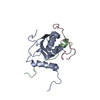
| |||||||||
|---|---|---|---|---|---|---|---|---|---|---|
| 1 |
| |||||||||
| NMR ensembles |
|
- Components
Components
| #1: Protein | Mass: 13495.979 Da / Num. of mol.: 1 / Fragment: UNP residues 25-138 Source method: isolated from a genetically manipulated source Source: (gene. exp.)  Strain: ATCC 204508 / S288c / Gene: IST3, SNU17, YIB5W, YIR005W / Plasmid: pETM-11 / Production host:  |
|---|---|
| #2: Protein/peptide | Mass: 2514.782 Da / Num. of mol.: 1 / Fragment: UNP residues 22-42 Source method: isolated from a genetically manipulated source Source: (gene. exp.)  Strain: ATCC 204508 / S288c / Gene: PML1, YLR016C, L1591 / Production host:  |
| #3: Protein/peptide | Mass: 3828.191 Da / Num. of mol.: 1 / Fragment: UNP residues 215-245 Source method: isolated from a genetically manipulated source Source: (gene. exp.)  Strain: ATCC 204508 / S288c / Gene: BUD13, CWC26, SLC7, YGL174W, G1642 / Production host:  |
| Compound details | AUTHORS STATE THAT THE ISOTOPICALLY LABELLED BIOSYNTHETIC PEPTIDES HAVE GS CLONING ARTIFACT AT THE ...AUTHORS STATE THAT THE ISOTOPICAL |
-Experimental details
-Experiment
| Experiment | Method: SOLUTION NMR | ||||||||||||||||||||||||||||||||||||||||||||||||||||||||||||||||||||||||||||||||||||||||||||||||||||||||||||||||||||||||||||||||||||||||||||||||||||||||||||||||||||||||
|---|---|---|---|---|---|---|---|---|---|---|---|---|---|---|---|---|---|---|---|---|---|---|---|---|---|---|---|---|---|---|---|---|---|---|---|---|---|---|---|---|---|---|---|---|---|---|---|---|---|---|---|---|---|---|---|---|---|---|---|---|---|---|---|---|---|---|---|---|---|---|---|---|---|---|---|---|---|---|---|---|---|---|---|---|---|---|---|---|---|---|---|---|---|---|---|---|---|---|---|---|---|---|---|---|---|---|---|---|---|---|---|---|---|---|---|---|---|---|---|---|---|---|---|---|---|---|---|---|---|---|---|---|---|---|---|---|---|---|---|---|---|---|---|---|---|---|---|---|---|---|---|---|---|---|---|---|---|---|---|---|---|---|---|---|---|---|---|---|---|
| NMR experiment |
|
- Sample preparation
Sample preparation
| Details |
| ||||||||||||||||||||||||||||||||||||||||||||||||||||||||||||||||||||||||||||||||||||||||||||||||||||||||||||||||||||||||||||||||||||||||||||||||||||||||||||||||||||||||||||||||||||||||||
|---|---|---|---|---|---|---|---|---|---|---|---|---|---|---|---|---|---|---|---|---|---|---|---|---|---|---|---|---|---|---|---|---|---|---|---|---|---|---|---|---|---|---|---|---|---|---|---|---|---|---|---|---|---|---|---|---|---|---|---|---|---|---|---|---|---|---|---|---|---|---|---|---|---|---|---|---|---|---|---|---|---|---|---|---|---|---|---|---|---|---|---|---|---|---|---|---|---|---|---|---|---|---|---|---|---|---|---|---|---|---|---|---|---|---|---|---|---|---|---|---|---|---|---|---|---|---|---|---|---|---|---|---|---|---|---|---|---|---|---|---|---|---|---|---|---|---|---|---|---|---|---|---|---|---|---|---|---|---|---|---|---|---|---|---|---|---|---|---|---|---|---|---|---|---|---|---|---|---|---|---|---|---|---|---|---|---|---|
| Sample |
| ||||||||||||||||||||||||||||||||||||||||||||||||||||||||||||||||||||||||||||||||||||||||||||||||||||||||||||||||||||||||||||||||||||||||||||||||||||||||||||||||||||||||||||||||||||||||||
| Sample conditions | pH: 6.8 / Pressure: ambient / Temperature: 308 K |
-NMR measurement
| NMR spectrometer |
|
|---|
- Processing
Processing
| NMR software |
| ||||||||||||||||||||||||
|---|---|---|---|---|---|---|---|---|---|---|---|---|---|---|---|---|---|---|---|---|---|---|---|---|---|
| Refinement | Method: simulated annealing / Software ordinal: 1 / Details: WATER REFINEMENT (RECOORD) | ||||||||||||||||||||||||
| NMR constraints | NOE constraints total: 4105 / NOE intraresidue total count: 769 / NOE long range total count: 1597 / NOE medium range total count: 775 / NOE sequential total count: 964 / Hydrogen bond constraints total count: 50 / Protein chi angle constraints total count: 0 / Protein other angle constraints total count: 0 / Protein phi angle constraints total count: 115 / Protein psi angle constraints total count: 115 | ||||||||||||||||||||||||
| NMR representative | Selection criteria: closest to the average | ||||||||||||||||||||||||
| NMR ensemble | Average torsion angle constraint violation: 0.62 ° / Conformer selection criteria: target function / Conformers calculated total number: 500 / Conformers submitted total number: 20 / Maximum lower distance constraint violation: 0 Å / Maximum torsion angle constraint violation: 3.2 ° / Maximum upper distance constraint violation: 0.307 Å / Torsion angle constraint violation method: CNS | ||||||||||||||||||||||||
| NMR ensemble rms | Distance rms dev: 0.0101 Å / Distance rms dev error: 0.0008 Å |
 Movie
Movie Controller
Controller


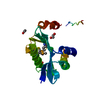
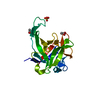
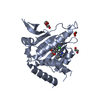



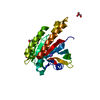
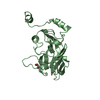
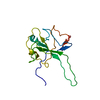

 PDBj
PDBj


 HSQC
HSQC